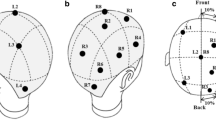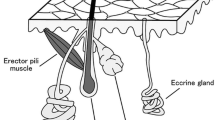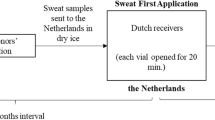Abstract
Tropical natives possess heat tolerance due to the ability to off-load endogenous and exogenous heat efficiently using a minimum amount of sweat. On the other hand, exposure of temperate natives to heat results in exaggerated production of sweat, of which part is lost by dripping and, thus, not available for evaporation. How sweating is modified in natives of temperate climate zones by prolonged residence in the tropics is not well-understood. The aim of this study was to investigate possible changes in the peripheral sweating mechanisms. Sweating responses to iontophoretically applied acetylcholine (ACh) were compared between Japanese subjects having either permanently resided in Japan (Japan resident Japanese, JRJ) or having stayed in the tropics for 2 years or longer (Tropics resident Japanese, TRJ). Quantitative sudomotor axon reflex tests by iontophoresis of ACh (10%, 2 mA for 5 min) were applied to determine directly activated (DIR) and axon reflex-mediated sweating during [AXR(1)] and after [AXR(2)] ACh iontophoresis. The sweat onset time of AXR(1) was 0.6 min shorter in JRJ than in TRJ (P<0.0001), and AXR(1) (P<0.0004), AXR(2) (P<0.0001), and DIR (P<0.0001) sweating responses were larger in JRJ than in TRJ. AXR and DIR sweating volumes (P<0.0001) were negatively correlated, and sweat onset times (P<0.0001) were positively correlated with the duration of residence in the tropics (2 to 13 years). The observed attenuation of sweating in TRJ suggests that temperate natives may acquire heat tolerance with improved sweating economy similar to tropical natives after prolonged residence in the tropics.





Similar content being viewed by others
References
Chemali KR, Gorodeski R, Chelimsky TC (2001) Alpha-adrenergic supersensitivity of the sudomotor nerve in complex regional pain syndrome. Ann Neurol 49:453–459
Chen YW, Elizondo RS (1974) Peripheral modification of thermoregulatory function during heat acclimation. J Appl Physiol 37:367–373
Griefahn B (1997) Acclimation to three different hot climates with equivalent wet bulb globe temperatures. Ergonomics 40:223–234
Horowitz M (1989) Heat acclimation: a continuum of process. In: Mercer J (ed) Thermal physiology 1989. Elsevier, Amsterdam, pp 445–451
Inoue Y, Havenith G, Kenney WL, Loomis JL, Buskirk ER (1999) Exercise-and methylcholine-induced sweating responses in older and younger men: effect of heat acclimation and aerobic fitness. Int J Biometeorol 42:210–216
Kosaka M, Othman T, Matsumoto T, Yamauchi M, Taimura A, Lee JB, Kaneda E, Owhatari N (2001) Central and peripheral control of sweating mechanisms: modification by thermal acclimatization and physical training. In: Kosaka M, Sugahara T, Schmidt KL, Simon E (eds) Thermotherapy for neoplasm inflammation and pain. Springer, Berlin Heidelberg New York, pp 95–105
Kuno Y (1956) Human perspiration. Charles C. Thomas, Springfield, IL
Lee JB, Matsumoto T, Othman T, Kosaka M (1997) Suppression of the sweat gland sensitivity to acetylcholine applied iontophoretically in tropical Africans compared to temperate Japanese. Trop Med 39:111–121
Lee JB, Bae JS, Lee MY, Min YK, Yang HM, Song HY, Ko KK, Kwon JT, Matsumoto T (2004) The change in peripheral sweating mechanisms of the tropical Malaysian who stays in Japan. J Therm Biol 29:743–747
Li X, Tokura H, Midorikawa T (1995) The effects of two different types of clothing on seasonal warm acclimatization. Int J Biometeorol 38:111–115
Low PA, Caskey PE, Tuck RR, Fealey RD, Dyck PJ (1983) Quantitative sudomotor axon reflex test in normal and neuropathic subjects. Ann Neurol 14:573–580
Matsumoto T, Kosaka M, Yamauchi M, Tsuchiya K, Ohwatari N, Motomura M, Otomasu K, Yang GJ, Lee JM, Boonayathap U, Praputpittaya C, Yongsiri A (1993) Study on mechanisms of heat acclimatization due to thermal sweating-comparison of heat-tolerance between Japanese and Thai subjects. Trop Med 35:23–34
Nadel ER, Pandolf KB, Roberts MF, Stolwijk JA (1974) Mechanisms of thermal acclimation to exercise and heat. J Appl Physiol 37:515–520
Nielsen B (1998) Heat acclimation-mechanisms of adaptation to exercise in the heat. Int J Sports Med 19(Suppl 2):S154–S156
Ogawa T, Sugenoya J (1993) Pulsatile sweating and sympathetic sudomotor activity. Jpn J Physiol 43:275–289
Torii M, Yamasaki M, Sasaki T (1996) Effect of prewarming in the cold season on thermoregulatory responses during exercise. Br J Sports Med 30:102–111
Wilkerson WJ, Young RJ, Melius JM (1986) Investigation of a fatal heat stroke. Am Ind Hyg Assoc J 47:A493–A494
Raynaud J, Martineaud JP, Bhatnagar OP, Vieillefond H, Durand J (1976) Body temperatures during rest and exercise in residents and sojourners in hot climate. Int J Biometeorol 20:309–317
Saat M, Tochihara Y, Hashiguchi N, Sirisinghe RG, Fujita M, Chou CM (2005) Effects of exercise in heat on thermoregulation of Japanese and Malaysian males. J Physiol Anthropol Appl Human Sci 24:267–275
Acknowledgements
The portion of this study was performed in the Department of Environmental Physiology, Institute of the Tropical Medicine, Nagasaki University, Japan. The authors extend theirs thanks to the subjects whose participation made this study possible. Jun-Sang Bae and Jeong-Beom Lee contributed equally to this work.
Author information
Authors and Affiliations
Corresponding author
Rights and permissions
About this article
Cite this article
Bae, JS., Lee, JB., Matsumoto, T. et al. Prolonged residence of temperate natives in the tropics produces a suppression of sweating. Pflugers Arch - Eur J Physiol 453, 67–72 (2006). https://doi.org/10.1007/s00424-006-0098-x
Received:
Revised:
Accepted:
Published:
Issue Date:
DOI: https://doi.org/10.1007/s00424-006-0098-x




